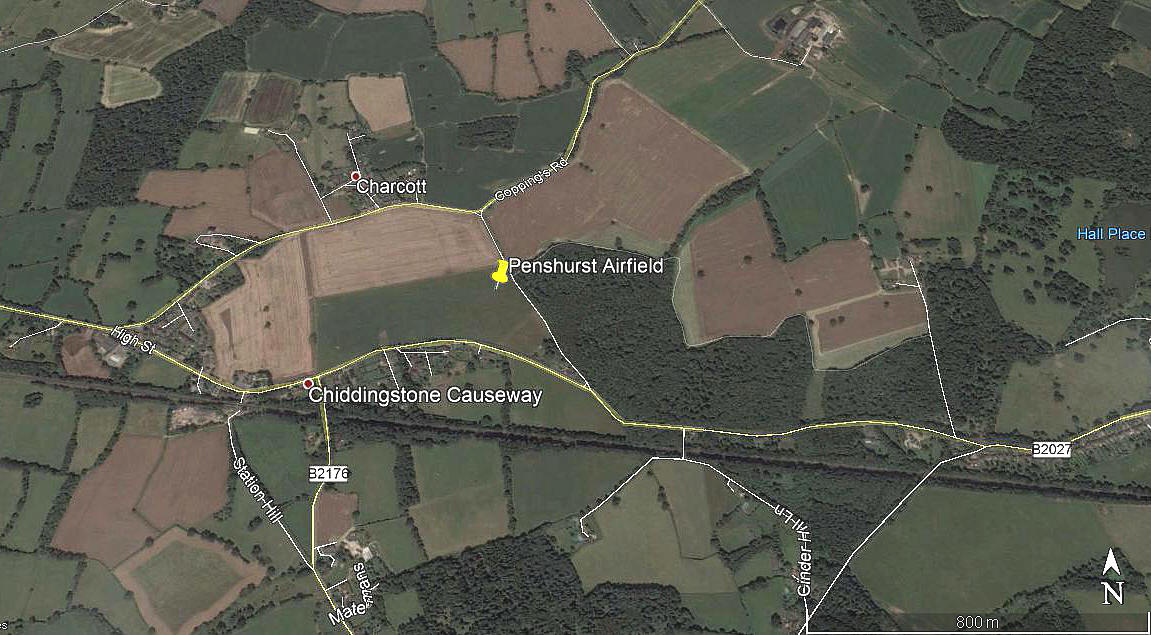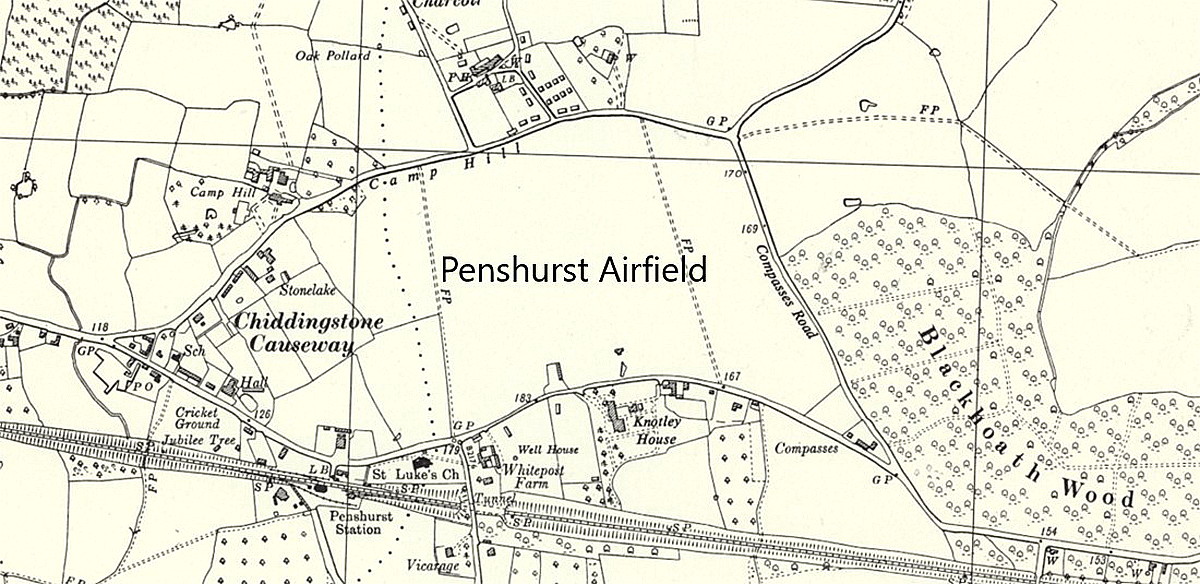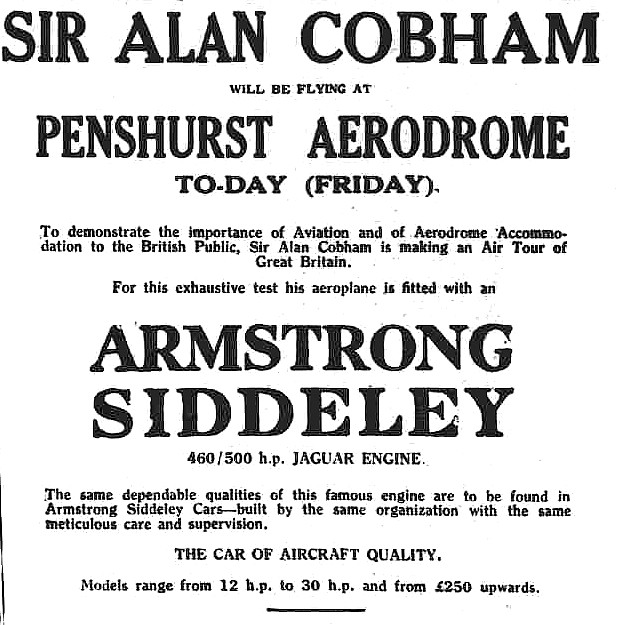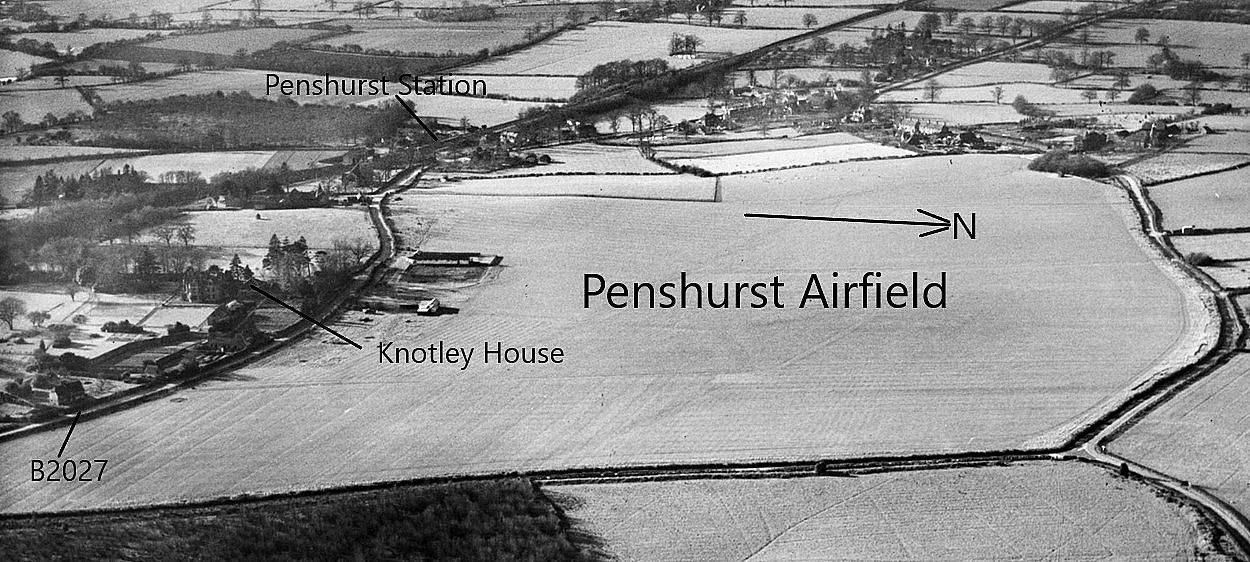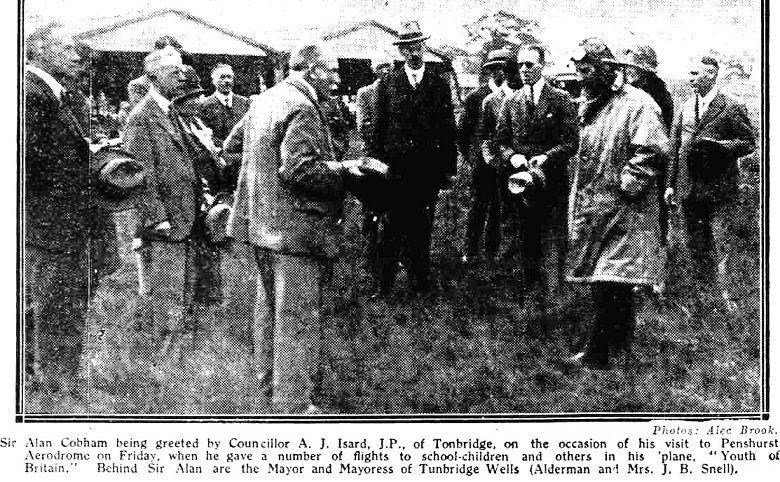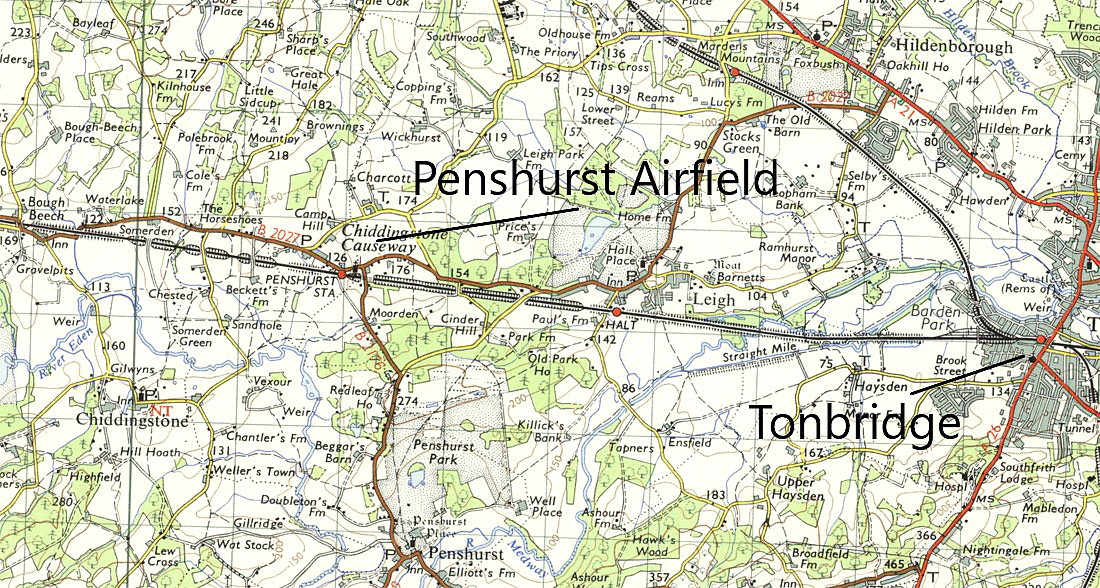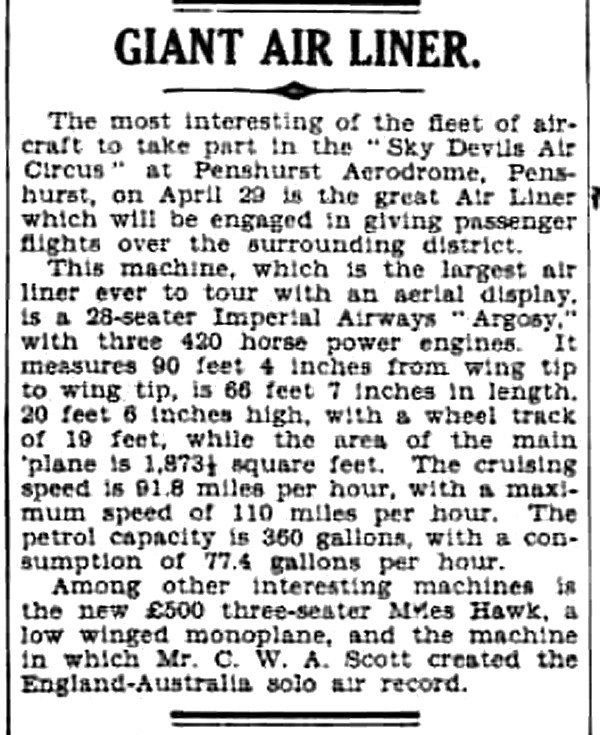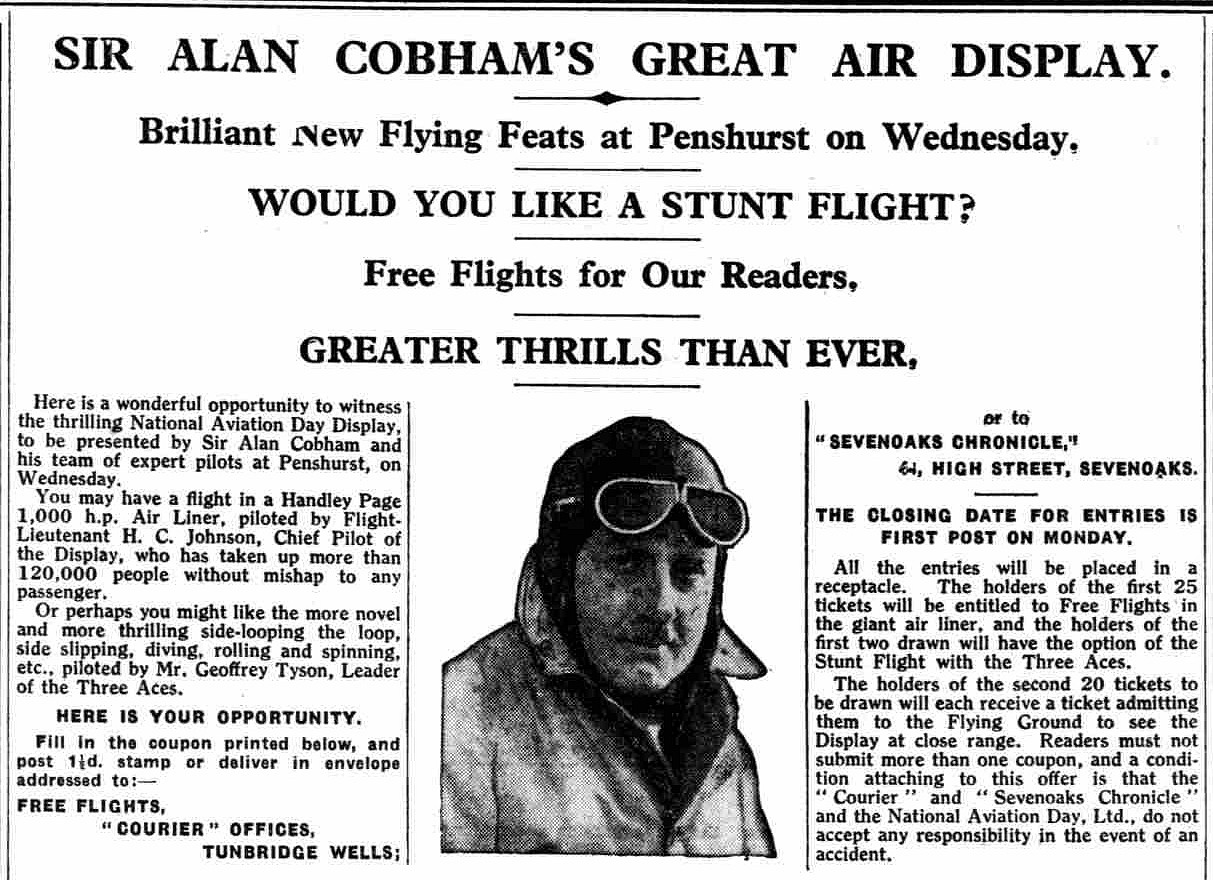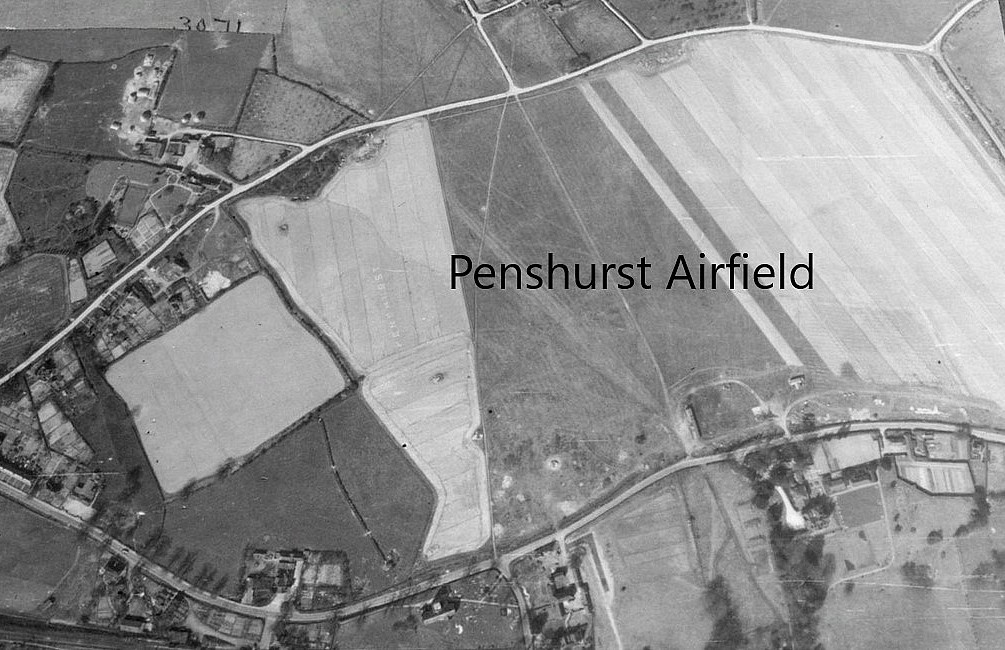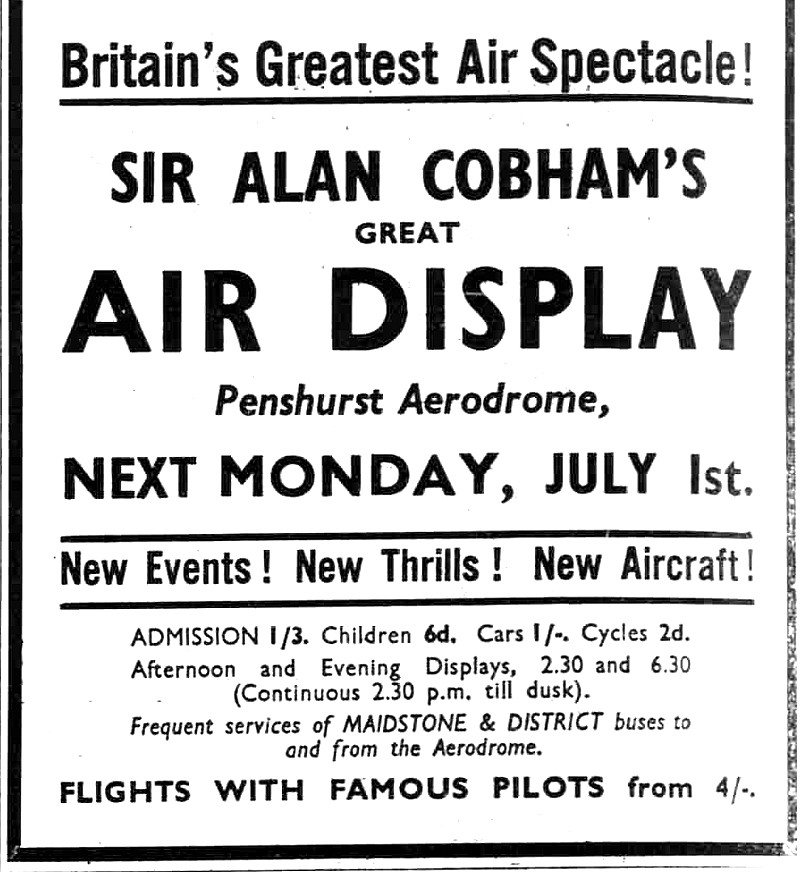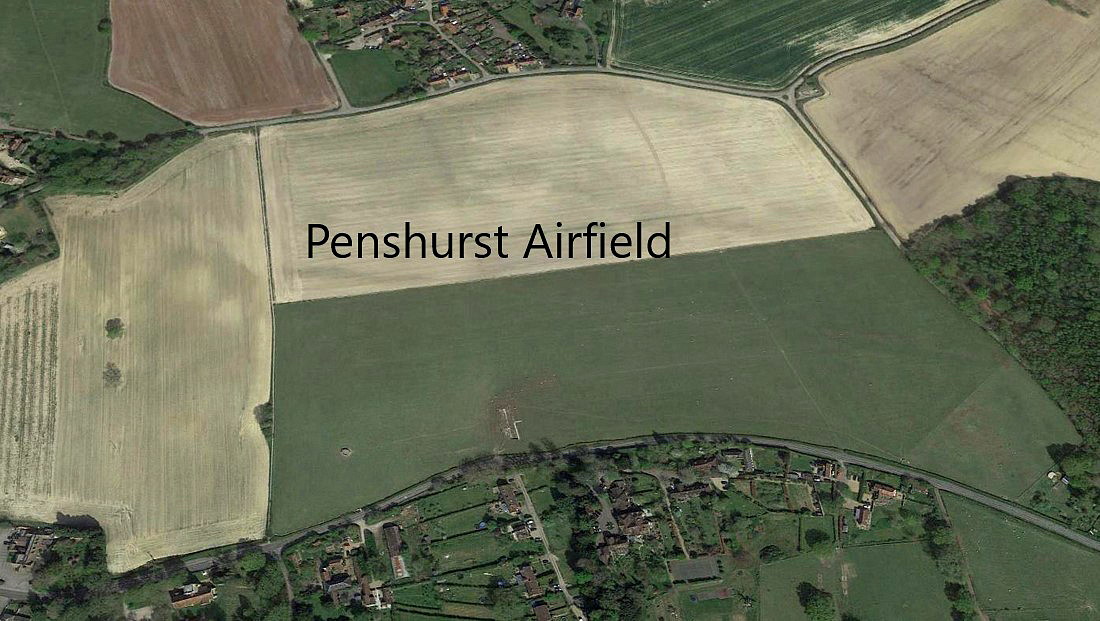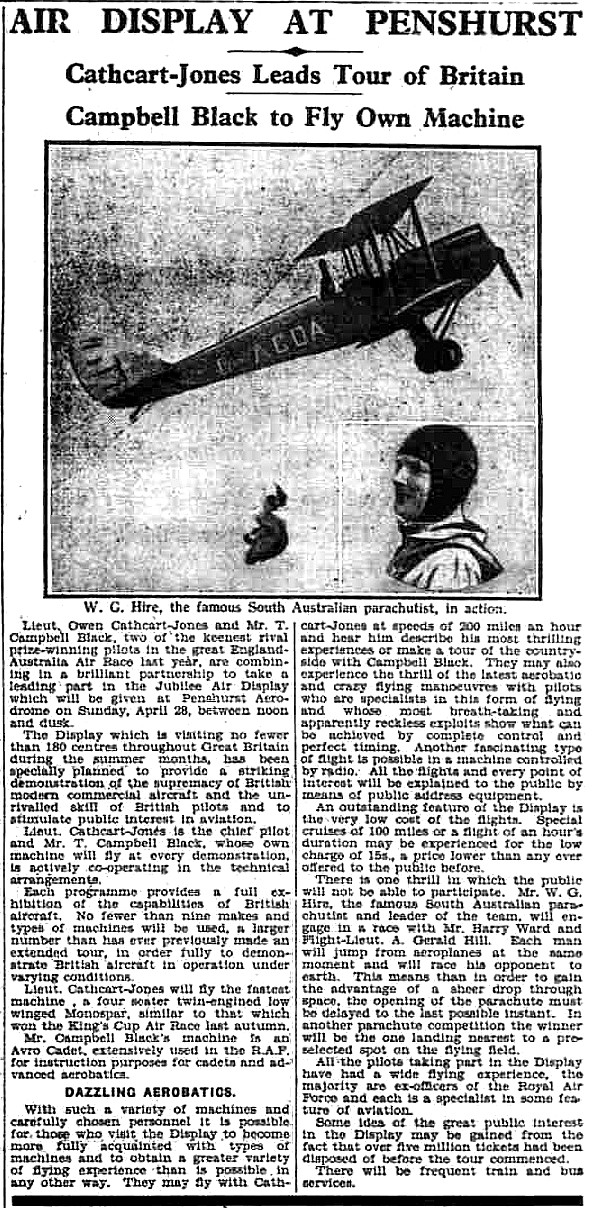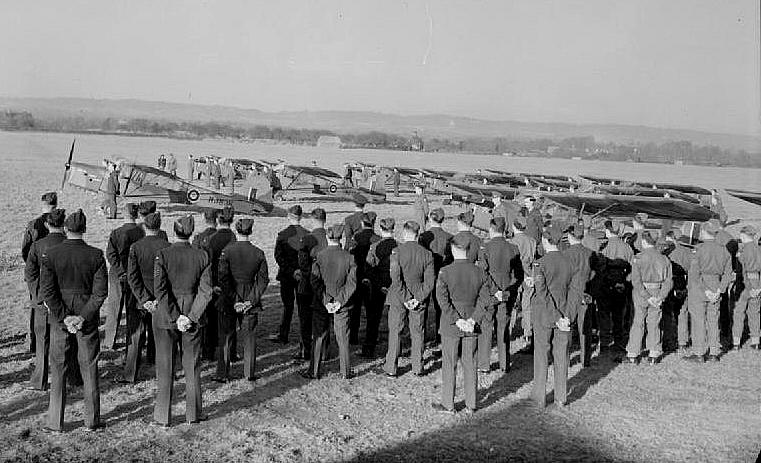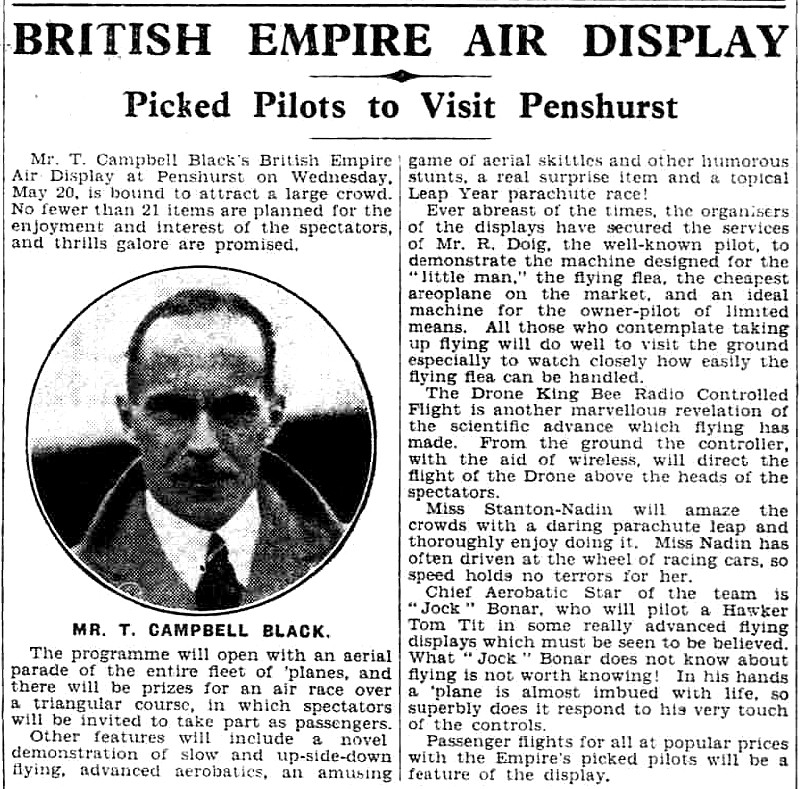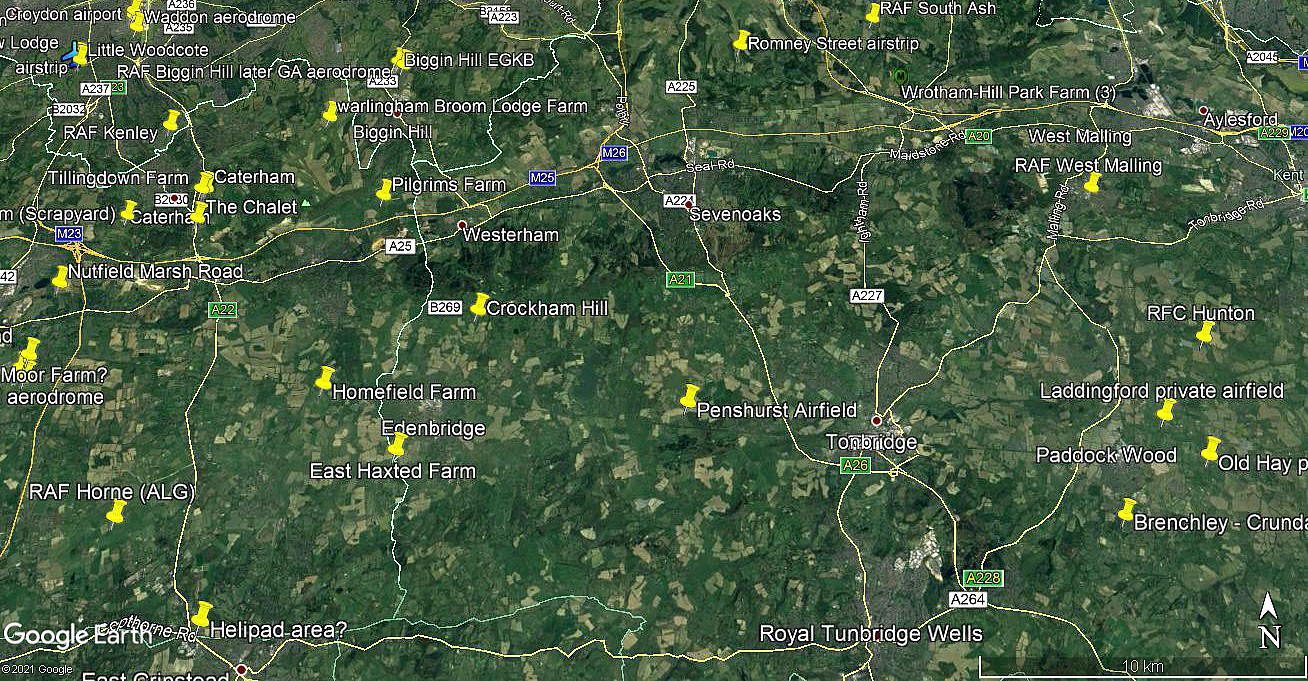Penshurst
PENSHURST: Military aerodrome in WW1, then civil aerodrome later WW2 military aerodrome
(Also known as CHIDDINGSTONE CAUSEWAY)
Note: This picture was obtained from Google Earth ©
Military users: WW1: Home Defence Flight Station later Night Landing Ground 1916 to 1919
78 Sqdn (BE.2c)
No.2 Wireless School (BE.2c, BE.2e, Sopwith Camels & Sopwith Snipes)
RFC/RAF School for VI Brigade 1917 to 1919
WW2: RAF Fighter Command 11 Group
ELG & RLG (Emergency Landing Ground & Relief Landing Ground)
Note: This said it appears that 268 Squadron, flying Curtiss Tomahawks were based here for a shortish period.
Army AOP: 653 Sqdn (Auster AOP.5s)
Operated by: 1930s: Air Travel Ltd
Pleasure flights: Pre 1940: Air Travel, Home Counties Aircraft Services, Stallard Airways
Location: N of B2027, 4nm NW of Royal Tunbridge Wells, in the grounds of Knotley Hall
Period of operation: Military: 1917 to 1919: Civil 1921 to 1922 initially? Then reopened in 1927 to 1936. Used by RAF Fighter Command and the Army for AOP duties from 1942 to 1945
Site area: WW1: 73 acres 731 x 457 (Some say 730 x 370)
Runways: 1933: Max landing run 732 grass
WW2: N/S 731 grass E/W 366 grass
A MICHAEL T HOLDER GALLERY
Note: This gallery mostly features events held at PENSHURST from 1929 until 1936. All the adverts and articles are from the Kent and Sussex Courier unless attributed elsewhere.
Notes: The 2nd item was published in the Sevenoaks Chronicle and Kentish Advertiser on the 16th August 1929.
Notes: The first picture was published on the 23rd August 1929. The second item was published on the 14th April 1933. This latter item is about the British Hospitals Air Pageant visit on the 12th April 1933. The fourth item, published on the 27th April 1934 concerned the impending visit by the Sky Devils Air Circus on the 29th April.
Notes: This article was published on the 22nd June 1934 and gives advance notice of the visit by Sir Alan Cobham's National Aviation Day Tour scheduled for the 27th June. That year the Tour was not split into two sections, unlike in 1933 and 1935, but even so 159 venues were planned for a visit. The third item is an advert for Cobham's 1935 No.1Tour, published on the 28th June, this being held on the Ist July and the first venue for the No.1 Tour.
Notes: This article, the first item, was published on the 26th April 1935 to announce the visit by the Jubilee Air Display on the 28th. The aircraft in the picture is the de Havilland DH60M Moth, G-ACOA.
The second item, a picture which Mike unearthed, is I think of special merit. It shows many Auster AOP (Air Observation Post), aircraft belonging to the 2nd Tactical Air Force. Taken between 1943 and 1945, you will be hard pushed to find any mention of AOP involvement in the 2nd Tactical Air Force, which really is quite shameful in so many ways. The humble Auster AOP is usually disregarded by so many as being not worth a mention. However, in so many ways, flying a slow unarmed light aircraft in a war zone, directing artillery, snooping around on recce duties, delivering essential orders, maps etc, is in fact a very hazardous business.
The third item is an announcement, published on the 15th May 1936, of the British Empire Air Display to be held on the 20th May. I have added the area view from my own Google Earth © database, simply to square this gallery off.
NOTES: It seems that PENSHURST was often used in the 1930s by various pilots and even airliners diverting. Especially when seeking CROYDON only to find it fogbound. But, regarding airliners in particular, what did the crews and passengers do after landing? Was there some form of accommodation for example, or transport to the nearest railway station? London fog or rather ‘smog’ (smoke filled fog) could last for days in that period - and indeed up until the late 50s at least.
After looking into the subject it appears that alternative means from a diversion, by rail and road, were well established - and worked remarkably well and smoothly. And of course, today, we need to remember that travel was often fraught with a whole range difficulties, which today many of us would find intolerable, especially those younger people who have never had, in the main, travelling anywhere without any inconvenience worthy of mention.
STALLARD AIRWAYS
Stallard Airways operated three Avro 504Ks and a DH.6 here in 1921 and 1922. A series of ‘mishaps’ caused the company and the airfield to close but it was reopened for private flying in 1927. In 1930 Home Counties Aircraft Services arrived with two DH.60 Moths and performed well over one thousand pleasure flights before moving to GATWICK later that year where the operation foundered due to lack of public interest.
This leads me to wonder about the commercial viability of a similar operation using DH Moths or other classic aeroplanes today based at GATWICK. I expect it could be very successful….don’t you? Run by a company like Air Atlantique for example who are brilliant at this sort of thing. I’d certainly be along for a ride or two and all that would be required was a few hundred metres of flattish mown grass at the edge of the airport and a tent. It wouldn’t interfere in any way with normal airport operations and could be used as a selling point for tourists using this airport when visiting the UK. Pie in the sky most would say but quite seriously - why not consider this sort of operation as a summer attraction at many big UK airports?
AIR TRAVEL
Air Travel was set up here in 1932 by Fred Holmes of Berkshire Aviation fame, after later being involved with Northern Air Transport. Air Travel also undertook aircraft overhaul and conversion work during their stay here before moving to GATWICK. Also operated from WALSALL in 1936.
During their period of operation between 1932 and 1937 Air Travel only operated Avro 504 types, mostly the 504N. Starting with two Avro 504K, G-ABUK, which crashed at HEDON near Hull on the 3rd September 1932 after being registered in March that year, the second example was G-ABVH which they operated from March 1932 until 1936. A third Avro 504K G-ABSN was operated from August 1933 until sold in December 1934.
The next two examples were Avro 504Ks modified to 504N. These being G-ABVY which was operated from April 1932 until March 1935 and G-ACCX. Acquired in February 1933 it crashed at Stewkley, Buckinghamshire on the 19th June 1934.
In all ten Avro 504N types were operated. G-ACLV was registered in November 1933, G-ACQD in March 1934 and G-ADBD in January 1935. All three were sold to National Aviation Displays in 1935, G-ACLV and G-ACQD in March, and G-ADBD in June. All three to take part in Sir Alan Cobhams final National Aviation Display tours.
Another four, G-ACOM registered in March 1934, G-AEDD registered in April 1936, G-AEIJ registered in May 1936 and G-AEMP, were all sold to Plane Advertising Ltd in 1936. Of the remaining three it appears that G-ADBM, registered in January 1935, was sold privately just two months later in March. G-ADBD, registered in November 1935, was sold to Canute Air Park Co in August 1936. Which I think was based at EASTLEIGH. G-AEGW, registered in April 1936, was sold privately in March 1937.
What I think needs to be remembered is that the Avro 504 first flew on the 18th September 1913. After fulfilling roles from trainer to bomber and night fighter in WW1, it was still in great demand in the mid to late 1930s as a joy-riding and banner-towing type. What is probably not widely known is that in WW2 the RAF still used it for radar trials. The only type of aircraft I am quite certain, that spanned a military career in both WW1 and WW2!
It appears that 11,303 Avro 504 variants were built, including some in Japan, the Soviet Union and other countries.
FLYING CIRCUS OPERATIONS
Venue for Alan Cobham’s 1929 Municipal Aerodrome Campaign Tour?
Venue (12th April) for the British Hospitals Air Pageant 1933 Tour of the UK
Venue (29th April) for the 1934 Sky Devils Air Circus Tour of the UK
Venue (27th June) for Alan Cobham’s 1934 Tour of the UK
Venue (28th April) for Jubilee Air Displays 1935 Tour
Venue (1st July) for Alan Cobham’s 1935 No.1 Tour of the UK
Venue (20th May) for British Empire Air Display 1936 Tour of the UK
AIR TRIPS
Also in the 1930s Pauline Gower and Dorothy Spicer based their Spartan Three-seater G-ABKK between here and OAKLEY WOOD in OXFORDSHIRE. It was here it seems that they formed the first all-woman aviation company in the UK, Air Trips, giving ‘joy-rides’. In WW2 Pauline Gower became a significant figure in the ATA (Air Transport Auxilliary)
CLOSURE
It now appears (2016) that PENSHURST closed in 1936 after a 'Flying Flea' crashed, presumably with fatal results, during an air display. Quite why this closure of an airfield should have occurred due to a crash, escapes me. Am I missing something? I cannot recall another example of an airfield closing because even a fatal crash had occurred. I suspect there is much more to be learned.
The 'Flying Fleas' were based on the Henri Mignet Pou-du-Ciel design for home-building by amateur constructors, and there was nothing much wrong with it - or so it seems. The main problem was that these constructors, mostly very poorly trained in flying, did not understand the crucial importance of weight and balance in such a small and light aircraft.
A RLG & ELG
Although listed as being simply a RLG (Relief Landing Ground) and an ELG (Emergency Landing Ground) for RAF Fighter Command, even at the end of 1944 the RAF had 192 personnel on station. It appears that the largest aircraft to perform an emergency land here was a Boeing B-17 Flying Fortess (43-37227, N7-X, The Prowler), of the USAAF 603 Bombardment Squadron based at NUTHAMSPSTEAD, HERTFORDSHIRE. Incredibly it seems it was repaired and flown out!
EXTRA NOTES: Although my information regarding PENSHURST has come from a wide variety of sources, arguably the most comprehensive source I have found today (2016) is the Wikipedia entry.
It now appears that Home Counties Aircraft Services Ltd had the de Havilland DH60M Moth, G-AAYF, based here from 10.07.30 until December 1932 when it was sold to Norway as N-50.
Michael T Holder
This comment was written on: 2020-05-21 14:48:02From the Sevenoaks Chronicle and Kentish Advertiser - Friday 23 August 1929 - a photograph of Sir Alan and local worthies after he had landed there on the Friday. He also gave a number of flights to school children and others that day.
We'd love to hear from you, so please scroll down to leave a comment!
Leave a comment ...
Copyright (c) UK Airfield Guide















